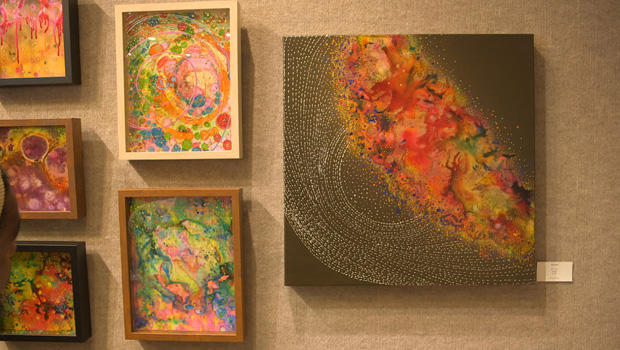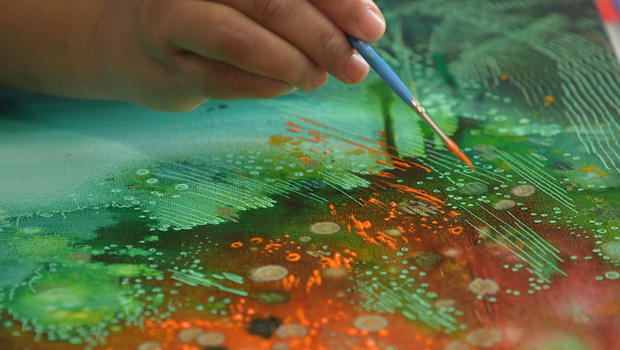Taking migraine seriously
Priya Rama's paintings are bright, often arresting with brilliant colors. But the source of those intense colors is intense pain. "The first thing I feel is pressure in my temples, almost like my head is getting squeezed in," she said.
Rama has suffered chronic migraine attacks most of her life. Five years ago, the Cincinnati artist began trying to paint them.
How does she paint a migraine? "When I close my eyes, I feel this imagery," she said. "It starts somewhere on the top, and it sort of floats down. And it's a symphony of colors."
But don't be fooled by that peaceful description.
"So, are you painting in the middle of the migraine?" asked correspondent Susan Spencer.
"Depends how functional I am and how painful it is," Rama said. Sometimes she paints during a migraine, but if it is overwhelming, she will later paint what she remembers.
At its most overwhelming, Rama has endured 25 attacks in a single month. "The headache is the dominant symptom," she said. "It is so debilitating that it crushes you. And you're unable to process or think or do anything at all. And then it affects my vision also. Sometimes it gets blurry, my vision. It affects your stomach."
"How does anybody live with this?" Spencer asked.
"What choice do you have, you know?" Rama replied.
She never leaves home without a purse full of medication: Zomig nasal spray, or Imitrex injections. It doesn't stop the pain, but can reduce the severity and duration of the attack.
Though the cause is unclear, migraine is a serious neurological disease that often runs in families, said Dr. William Young, a neurologist and headache specialist at Thomas Jefferson University Hospital in Philadelphia.
Spencer asked, "I think when people hear the word 'migraine,' they think a really, really bad headache. How accurate is that?"
"It's pretty inaccurate," Dr. Young replied. "It's a headache and it's usually really bad. But it also has light sensitivity, nausea, sound sensitivity, smell sensitivity, brain fog, dizziness, and a host of other symptoms that are often attached to it."
"And this can last for how long?"
"Well, I have patients who never get rid of their migraine," Dr. Young said. "Every single day, in every moment of every day."
Fortunately, that's rare. The disease, unfortunately, is not. According to Dr. Young, about 40 million Americans have migraine — and in the world, a billion people suffer. That's about one in seven living with what's ranked as the second-most-debilitating disease on the planet (right after back pain.)
Just how debilitating? Watch what happened to TV reporter Serene Branson, of CBS station KCBS, in 2011, during a live broadcast:
Dr. Young said, "Everybody was sure that she had had a major stroke."
"It almost seems like she's speaking in tongues," said Spencer. "And that's migraine?"
"The most common place is in the vision part of the brain, but in her case, it was in the language part of the brain," he said.
A new class of drugs can reduce the number of attacks, and handheld electrical devices to block pain can help some patients. But there is no cure, and often no real diagnosis.
Typically, you can't see a migraine on a brain scan.
"Migraine is still a radically-undertreated disorder," said medical historian Katherine Foxhall, author of "Migraine: A History" (Johns Hopkins University Press).
The disease, she said, can be traced back for thousands of years, and over the centuries it has been treated with everything from wrapping the patient's head with ground-up earthworms, to bloodletting.
As for why we're not much better at treating it today, Foxhall said, "One of the problems we have at the moment with migraine is really that it's not taken that seriously."
She thinks that's largely because migraine affects three times as many women as men. "It's often seen as an excuse," Foxhall said. "It's seen as a disorder of women – you know, women who can't really cope with modern life, or, you know, who are too stressed."
Spencer asked Dr. Young, "If this were men, we wouldn't be in the same situation?"
"There is no way that the second-most-disabling disease in the world would get this little attention if it was happening to men principally," he replied.
Dr. Young heads up Miles for Migraine, which hosts running events aimed at raising awareness. "Don't let anybody ever say that it's just a headache," he told participants.
He told Spencer, "If society tells you it's not valid to have migraine headache, that you shouldn't be disabled, that it's there because you're weak, you are not gonna be a good advocate for yourself when it comes to getting treatment."
"Even though it's that common, people are uncomfortable admitting it?" Spencer asked.
"Right. So, they hide it. They don't seek help. They don't talk about it, because they know how little sympathy they're gonna get if they say, you know, they need to miss work."
That stigma, he said, has a dramatic effect on research. The National Institutes of Health budget for arthritis, for example, is about ten times that for migraine, though the two have a comparable impact on society.
Dr. Young said, "If migraine was treated fairly by NIH, it would get $240 million worth of research. It gets about $20 [million]."
"We obviously have limited funds, and so we have to be really careful how we spread them across the different diseases that we're responsible for," said Linda Porter, an NIH director in the National Institute of Neurological Disorders and Stroke. She said funding for migraine research is on the rise.
"It's a slow process. So, we've gone, in 2015, from about $22 million a year commitment, and now, we're getting up into the high 30s over a small number of years."
Spencer asked Dr. Young, "Is that satisfactory, as far as you're concerned?"
He replied, "You know, if minimum wage goes from $6 to six and a half dollars, no, it's not satisfactory. You know, it's shamefully poor."
Spencer asked Porter, "Do you feel like this is getting enough attention?"
"I feel like it's getting enough attention," she replied. "I think there is a need for more funding in the area because there are some critical gaps."
Gaps she blames in part on a shortage of migraine researchers, and the difficulty of treating people whose symptoms vary so widely.
"Headaches don't affect people all the same way," Porter said. "It's not an easy equation of, how do I treat this patient to make them feel better, because it's not a one-size-fits-all."
Small comfort to people like Priya Rama. She said the impact of migraine on her life is so great, she'd even give up painting if it also meant giving up pain.
Spencer asked her, "If I told you that tomorrow there's a cure – you know, you take this little pill once a month and you'll never have another migraine …"
"I would do it," Rama replied. "Am I gonna stop seeing these visions and not have anything to paint? Maybe. But if I cannot deal with the pain at all, I would certainly take that."
BOOK EXCERPT: "Migraine: A History"
For more info:
- Migraine artist Priya Rama: Transforming pain into beauty
- Dr. William Young, Thomas Jefferson University Hospital, Philadelphia
- Miles for Migraine
- "Migraine: A History" by Katherine Foxhall (Johns Hopkins University Press), in Trade Paperback and eBook formats, available via Amazon
- National Institute of Neurological Disorders and Stroke (NIH)
- Thanks to Shakespeare & Co. Booksellers, New York City
Story produced by Amiel Weisfogel.







